-
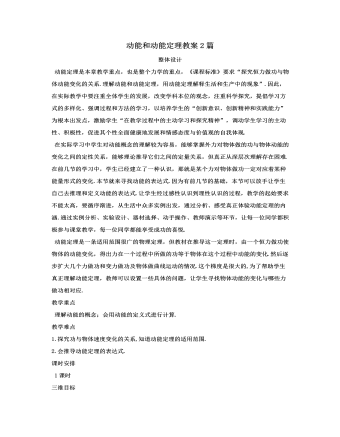
人教版新课标高中物理必修2动能和动能定理教案2篇
二、课堂教学(课前由科代表发回预习学案)1、教师根据预习学案检查结果提出问题(用多媒体展示),引导全班讨论(重点讨论:①、为什么动能的表达式一定是 mV2 ?你如何得出这个结论?②、力在一个过程中对物体所做的功,和物体在这个过程中动能的变化量有什么关系?你如何得出这个结论?这个做功的力和F=ma中的力F有什么关系)。有困难的小组应及时问老师。老师在这个过程中巡视指导。2、学生自主阅读课文“7 动能和动能定理”中的“动能的表达式”,然后完成如下练习(教师在此过程中巡视指导):2.1尝试推出动能的表达式(鼓励会推导的同学积极上台板演,老师引导讨论)。2.2写出动能的小结(认真阅读教材p66倒数第二段、第三段,结合你推导动能表达式的过程,认真思考后四人一组讨论:①、动能是矢量还是标量?②、动能的单位是什么?③、你认为应从哪几方面来理解动能?)
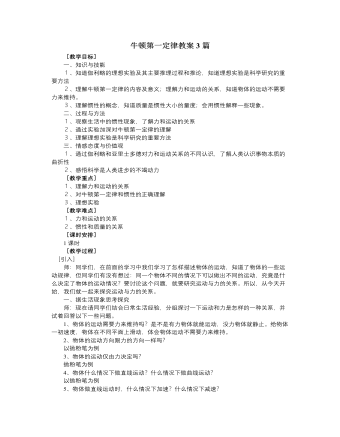
人教版新课标高中物理必修1牛顿第一定律教案3篇
一、知识与技能1、知道伽利略的理想实验及其主要推理过程和推论,知道理想实验是科学研究的重要方法2、理解牛顿第一定律的内容及意义;理解力和运动的关系,知道物体的运动不需要力来维持。3、理解惯性的概念,知道质量是惯性大小的量度;会用惯性解释一些现象。二、过程与方法1、观察生活中的惯性现象,了解力和运动的关系2、通过实验加深对牛顿第一定律的理解3、理解理想实验是科学研究的重要方法三、情感态度与价值观1、通过伽利略和亚里士多德对力和运动关系的不同认识,了解人类认识事物本质的曲折性2、感悟科学是人类进步的不竭动力[教学重点]1、理解力和运动的关系2、对牛顿第一定律和惯性的正确理解3、理想实验[教学难点]1、力和运动的关系2、惯性和质量的关系
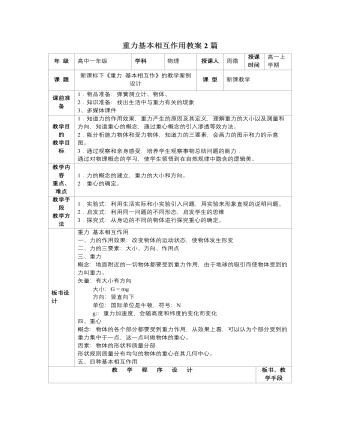
人教版新课标高中物理必修1重力基本相互作用教案2篇
具体过程:先用悬挂法确定重心之后,在板上固定一条细线ab,让ab穿过重心c点,再在其重心c处拴上细绳提拉,验证薄板可以水平平衡.如图3-1-6、3-1-7所示.归纳:物体的重心可在物体之上,也可在物体之外.结论:规则均匀的物体重心在其几何中心;不规则不均匀的物体重心用悬挂法.例3一个被吊着的均匀的球壳,其内部注满了水,在球的底部有一带阀门的细出水口.在打开阀门让水慢慢流出的过程中,球壳与其中的水的共同重心将会()A.一直下降B.一直不变C.先下降后上升D.先上升后下降先让学生自己回答,估计很多学生会选择A;教师提示开始和最终重心的位置,学生很快就能得出正确答案.借机引导学生思考问题要全面.参考答案:在注满水时,球壳和水的共同重心在球心,随着水的流出,球壳的重心不变,但是水的重心下降,二者共同的重心在下降.当水流完时,重心又回到球心,故选项C正确.
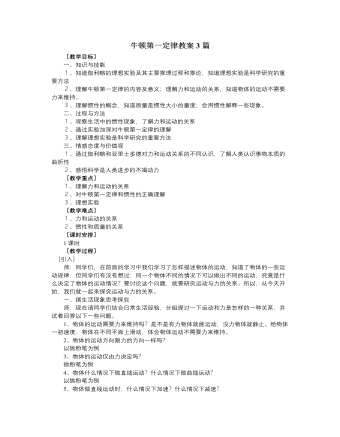
人教版新课标高中物理必修1牛顿第一定律教案3篇
一、知识与技能1、知道伽利略的理想实验及其主要推理过程和推论,知道理想实验是科学研究的重要方法2、理解牛顿第一定律的内容及意义;理解力和运动的关系,知道物体的运动不需要力来维持。3、理解惯性的概念,知道质量是惯性大小的量度;会用惯性解释一些现象。二、过程与方法1、观察生活中的惯性现象,了解力和运动的关系2、通过实验加深对牛顿第一定律的理解3、理解理想实验是科学研究的重要方法三、情感态度与价值观1、通过伽利略和亚里士多德对力和运动关系的不同认识,了解人类认识事物本质的曲折性2、感悟科学是人类进步的不竭动力[教学重点]1、理解力和运动的关系2、对牛顿第一定律和惯性的正确理解3、理想实验[教学难点]1、力和运动的关系2、惯性和质量的关系[课时安排]1课时[教学过程][引入]
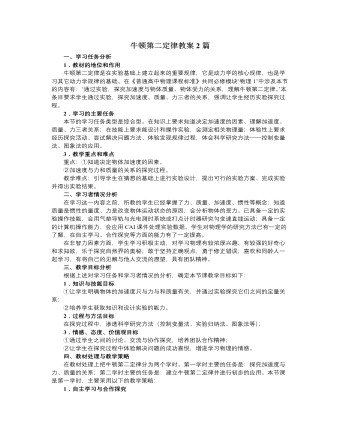
人教版新课标高中物理必修1牛顿第二定律教案2篇
1.这节课以实验为依据,采用控制变量的方法进行研究。这一方法今后在电学、热学的研究中还要用到。我们根据已掌握的知识设计实验、探索规律是物体研究的重要方法。2.定义力的单位“牛顿”使得k=1,得到牛顿第二定律的简单形式F=ma。使用简捷的数学语言表达物理规律是物理学的特征之一,但应知道它所对应的文字内容和意义。3.牛顿第二定律概括了运动和力的关系。物体所受合外力恒定,其加速度恒定;合外力为零,加速度为零。即合外力决定了加速度,而加速度影响着物体的运动情况。因此,牛顿第二定律是把前两章力和物体的运动构成一个整体,其中的纽带就是加速度。四、评价方案及说明1、对科学知识与技能的评价要注重科学内容的理解与应用,而不是单纯记忆。技能的评价目标包括观察技能、实验技能等方面。对科学的技能的评价要尽量融合在科学探究过程的情景中。对科学知识的评价主要从两方面,一是根据学生诊断性练习;二是通过学生作业反映学生掌握情况。
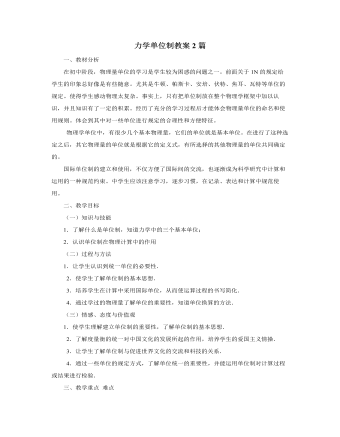
人教版新课标高中物理必修1力学单位制教案2篇
一、教材分析在初中阶段,物理量单位的学习是学生较为困惑的问题之一。前面关于1N的规定给学生的印象总好像是有些随意。尤其是牛顿、帕斯卡、安培、伏特、焦耳、瓦特等单位的规定。使得学生感动物理太复杂。事实上,只有把单位制放在整个物理学框架中加以认识,并且知识有了一定的积累。经历了充分的学习过程后才能体会物理量单位的命名和使用规则。体会到其中对一些单位进行规定的合理性和方便特征。物理学单位中,有很少几个基本物理量,它们的单位就是基本单位。在进行了这种选定之后,其它物理量的单位就是根据它的定义式,有所选择的其他物理量的单位共同确定的。国际单位制的建立和使用,不仅方便了国际间的交流,也逐渐成为科学研究中计算和运用的一种规范约束。中学生应该注意学习,逐步习惯,在记录、表达和计算中规范使用。二、教学目标(一)知识与技能1.了解什么是单位制,知道力学中的三个基本单位;2.认识单位制在物理计算中的作用
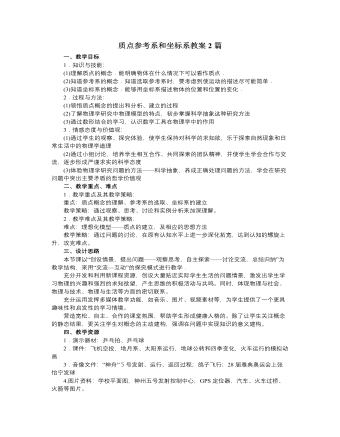
人教版新课标高中物理必修1质点参考系和坐标系教案2篇
①平动的物体一般可以看作质点做平动的物体,由于物体上各点的运动情况相同,可以用一个点代表整个物体的运动,在这种情况下,物体的大小、形状就无关紧要了,可以把整个物体当质点。例如:平直公路上行驶的汽车,车身上各部分的运动情况相同,当我们把汽车作为一个整体来研究它的运动的时候,就可以把汽车当作质点。当然,假如我们需要研究汽车轮胎的运动,由于轮胎上各部分运动情况不相同,那就不能把它看作质点了。要注意的是:同一物体在不同情况下有时可看质点,有时不可以看作质点,一列火车从北京开到上海,研究火车的运行的时间,可将火车看成质点,而火车过桥时,计算火车过桥的时间,不可以将火车看成质点。②有转动但转动为次要因素例如:研究地球公转时,可把地球看作质点;研究地球自转时,不能把地球看作质点。③物体的形状、大小可忽略再如:乒乓球旋转对球的运动的较大的影响,运动员在发球、击球时都要考虑,就不能把乒乓球简单看作质点。
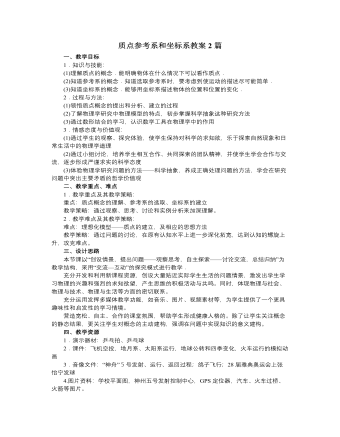
人教版新课标高中物理必修1质点参考系和坐标系教案2篇
(创设实例:多媒体播放视频刘翔的110m栏。)1.提出问题:怎样定量(准确)人描述车或刘翔所在的位置?2.提示:你的描述必须能反映物体(或人)的运动特点(直线)、运动方向、各点之间的距离等因素。3.总结:①为了定量地描述物体的位置及位置的变化,需要在参考系上建立适当的坐标系。坐标系是在参考系的基础上抽象出来的概念,是抽象化的参考系。为了定量地描述物体的位置及位置的变化需要在参考系上建立适当的坐标系,如果物体在一维空间运动,即沿一条直线运动,只需建立直线坐标系,就能准确表达物体的位置;如果物体在二维空间运动,即在同一平面运动,就需要建立平面直角坐标系来描述物体的位置;当物体在三维空间运动时,则需要建立三维坐标系。①一维坐标:描述物体在一条直线上运动,即物体做一维运动时,可以以这条直线为x轴,在直线上规定原点、正方向和单位长度,建立直线坐标系。如图1-1-1所示,若某一物体运动到A点,此时它的位置坐标XA=3m,若它运动到B点,则此时它的坐标XB=-2m(“-”表示沿X轴负方向)。
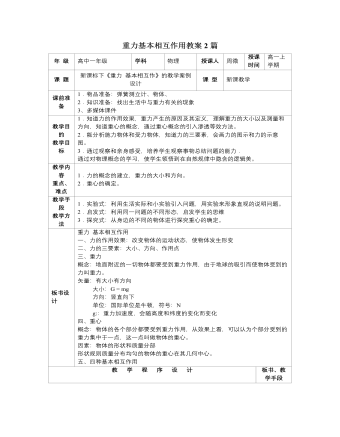
人教版新课标高中物理必修1重力基本相互作用教案2篇
阅读教材后总结:是万有引力的作用把宇宙中的恒星和行星聚集在一起,组成了太阳系、银河系和其他星系.力的相互作用遍布我们周围的一切物体.除此之外还有电荷间的相互作用、磁体间的相互作用,我们把这种力称为电磁相互作用.【思考与讨论】质子带正电,但质子(与中子一起)却能聚集在一起构成原子核.你能推测是什么力的作用结果吗?攻略一:阅读教材53页,师生共同讨论、总结.攻略二:网络搜索或工具书查阅“四种基本相互作用”,进一步了解概念.结论:决定物质的结构和变化过程的基本的相互作用.近代物理确认各种物质之间的基本的相互作用可归结为四种:引力相互作用、电磁相互作用、弱相互作用和强相互作用.近代物理的观点倾向于认为:四种基本相互作用是统一的,物理学家们正在为建立大统一理论而努力.但至今也没有公认的结论,望同学们好好学习,为科学事业奉献自己的聪明和才智.

人教版新课标高中物理必修2曲线运动教案2篇
1、教师先演示投影:把小钢珠放在黑墨水瓶盖里转一下(内有一点点墨水),再放在半圆形有机玻璃轨道上运动并飞出,让钢珠在白纸上留下痕迹,同样在3/5半圆周,4/5半圆周上运动飞出,让学生猜测飞出方向由什么特点?(有机玻璃板说明:厚约5毫米,略小于小钢珠直径,圆弧半径15厘米,MN边稍长些,以便过MN做直线,根据半径大小确定圆心O位置。)学生猜想:切线方向师:已知圆弧半径为15厘米。如何验证?请用几何方法作图验证。生:标出飞出点和圆心,做圆心和飞出点的连线,用量角尺量出该连线和飞出轨迹直线的夹角,是否90度。2、再分组实验,提醒同桌配合,小心钢珠滚跑。实验完毕,要求作图验证,并互相讨论交流。3、交流和结论:师:要引导学生得出正确的科学结论:“圆周运动的物体的速度方向为该点的切线方向”,而不能直接得出“曲线运动的的物体速度方向为该点的切线方向”。
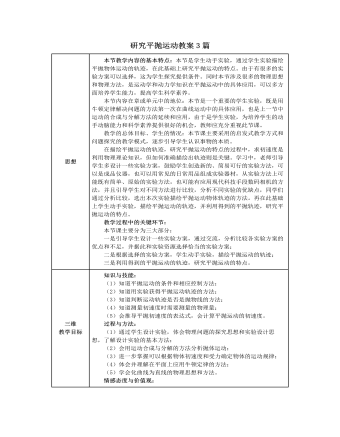
人教版新课标高中物理必修2研究平抛运动教案3篇
(给出仪器后先让学生思考如何设计实验、安装仪器、设计实验步骤,而后教师总结)实验步骤如下:①安装调整斜槽 :用图钉把白纸钉在竖直板上,在木板的左上角固定斜槽。②调整木板 :用悬挂在槽口的重锤线把木板调整到竖直方向,并使木板平面与小球下落的竖直面平行,然后把重锤线方向记录到钉在木板上的白纸上,固定木板,使在重复实验的过程中,木板与斜槽的相对位置保持不变。③确定坐标原点:把小球放在槽口处,用铅笔记下小球在槽口时球心在木板上的水平投影点O,O即为坐标原点。④描绘运动轨迹 :用铅笔的笔尖轻轻地靠在木板的平面上,不断调整笔尖的位置,使从斜槽上滚下的小球正好碰到笔尖,然后就用铅笔在该处白纸上点上一个黑点,这就记下了小球球心所对应的位置。保证小球每次从槽上开始滚下的位置都相同,用同样的方法可找出小球平抛轨迹上的一系列位置。取下白纸,描绘小球做平抛运动的轨迹。
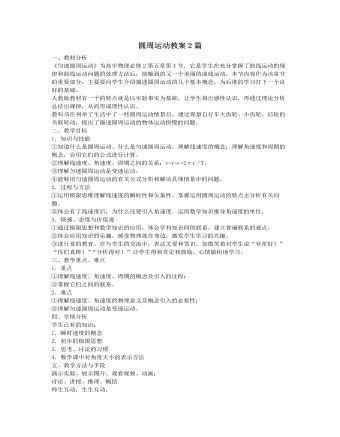
人教版新课标高中物理必修2圆周运动教案2篇
《匀速圆周运动》为高中物理必修2第五章第4节.它是学生在充分掌握了曲线运动的规律和曲线运动问题的处理方法后,接触到的又一个美丽的曲线运动,本节内容作为该章节的重要部分,主要要向学生介绍描述圆周运动的几个基本概念,为后继的学习打下一个良好的基础。人教版教材有一个的特点就是以实验事实为基础,让学生得出感性认识,再通过理论分析总结出规律,从而形成理性认识。教科书在列举了生活中了一些圆周运动情景后,通过观察自行车大齿轮、小齿轮、后轮的关联转动,提出了描述圆周运动的物体运动快慢的问题。二、教学目标1.知识与技能①知道什么是圆周运动、什么是匀速圆周运动。理解线速度的概念;理解角速度和周期的概念,会用它们的公式进行计算。②理解线速度、角速度、周期之间的关系:v=rω=2πr/T。③理解匀速圆周运动是变速运动。④能够用匀速圆周运动的有关公式分析和解决具体情景中的问题。

人教版高中历史必修2开辟新航路教案
材料五航路开辟后,东方香料输入欧洲的总量较中古之时猛增30倍,而胡椒、丁香等在印度购入和在英国卖出的差价亦高达10至29倍,其他货物的获利同样惊人。这一时期,新的商品不断涌现,特别值得注意的是美洲的特产——玉米、马铃薯、烟草、可可等——被传播到欧亚大陆。这时,世界性的对外贸易主要通过大西洋,地中海与意大利皆告衰落,而沿大洋的英、荷等渐居中心。到17世纪时,英国的伦敦与荷兰的阿姆斯特丹成为世界贸易中心。问题4:材料五表明,新航路开辟后对世界贸易产生了哪些重大影响?答案4:结束了世界相对孤立状态;各地文明开始会合交流,日益连成一个整体;欧洲商人直接同世界各地建立商业联系;促进不同国家和贸易的发展,促进世界市场雏形开始出现。

新人教版高中英语必修2Unit 2 Wildlife Protection-Reading for Writing教案二
This lesson aims at making a poster about protecting wildlife after reading some posters. During reading students are guided to understand the content and try to summarize the posters with one sentence. Then students are guided to try to make a poster about protecting wildlife.1. Read the two posters and try to understand the summary sentences.2. Look at the two posters and try to understand what emotions they express.3. Try to summarize the features of posters4. Try to make a poster about wildlife.1. Look at the two posters and try to understand what emotions they express.2. Try to summarize the features of posters3. Try to make a poster about wildlife.Step 1 Lead inLook at the the posters on the textbook and ask:Which emotions do the posters communicate ?Step 2 Read the poster and answer the questions.1. What do you think of the animals in the poster on the left ?I think it is frightening and ugly.2. Why do we should protect the ugly animals ?All species--the good, the bad, and the ugly-- should be treated equally.The world needs all kinds--without variety, our planet cannot survive.3. Why are billions of trees being cut down every year ?To make paper for humans.4. What result will be lead to after the trees are cut down ?A lost of animal homes are being destroyed./The habitat of wildlife is being destroyed.Step 3 Find the feature of posters1. What does each poster use to stir up emotions ?On the left, it makes us a little frightened and it looks a little ugly, but it can activate our curiosity--What is it? And What is wrong with it?On the right, it makes us feel a little sad and want to protect them.

新人教版高中英语必修2Unit 2 Wildlife Protection-Discovering Useful Structure教案二
2.表示现阶段正在进行的被动动作(该动作在说话的瞬间未必正在进行)。Many interesting experiments are being carried out these days.(说话时,并不一定正在进行)3.表示一种经常性的被动行为,常和always,constantly 等表示频度的副词连用,这种用法常常带有赞扬或厌恶的感情色彩。He is always being praised by the leader.4.表示按计划或安排主语将要承受谓语动词所表示的动作(仅限于少数及物动词)。A party is being held tonight.Step 4 Special cases1.像take care of, look after, talk about, think of等动词与介词构成的短语用于现在进行时的被动语态时, 其中的介词不可省略。The ways to stop illegally hunting are being talked about. 2.可与部分情态动词连用,表示对正在发生的事情的推测。She may be being punished by her mother.3.有时可表示按计划或安排将要进行的一个被动动作。A celebration is being held this weekend for his success.4.某些表示“状态、心理活动、存在”等的动词,如have,want,need,love,一般不用现在进行时的被动语态,而常用一般现在时的被动语态。With the population increasing,more land is needed.5.“be+under/in+n.”可表示现在进行时的被动意义。My computer is under repair.=My computer is being repaired.

新人教版高中英语必修2Unit 2 Wildlife Protection-Discovering Useful Structure教案一
The activity topic of this section is "report an ongoing event", and the structure is the passive voice of present continuous tense. Rare wild animals are suffering from large-scale poaching, and species are on the brink of danger. Rescue operations are underway. "Being" and "suffering" are the meanings of the present progressive passive voice.The usage of present progressive passive voice is of great importance in writing a good discourse and appreciating some difficult language items, so it is vital to master it and use it flexibly in a context.1. Motivate Ss to deepen the understanding of the usage of present progressive passive voice in a fixed context.2. Enable Ss to master the usage of present progressive passive voice and use it flexibly in a context.3. Lead Ss to construct sentences or appreciate sentences used master it and use it flexibly in a context.1. Help students to appreciate the function of the usage of present progressive passive voice in a sentence2. Instruct students to write essays using the proper usage of present progressive passive voice.Look at the picture and tell me what are workers doing? What is the house being done?

新人教版高中英语必修2Unit 2 Wildlife Protection-Reading and Thinking教案一
The listening and speaking part aims at how to protect and help endangered animals by listening, speaking and talking about the facts and reasons. This lesson analyzes the decreasing clause of Tibetan antelope population and the measures of protecting Tibetan antelopes. So students can be guided to learn to analyse the title and use different reading skills or strategies, like scanning, skimming and careful reading.1. Read quickly to get the main ideas and the purpose of going to Tibetan; read carefully to understand what the author see and think.2. Understand the sentences of the present continuous passive voice such as “Much is being done to protect wildlife.” and the inverted sentence “Only when we learn to exist in harmony with nature can we stop being a threat to wildlife and to our planet.”3. Enhance the awareness of protecting wildlife.4. Cultivate the reading methods according to different materials.1. Read quickly to get the main ideas and the purpose of going to Tibetan; read carefully to understand what the author see and think.2. Understand the sentences of the present continuous passive voice such as “Much is being done to protect wildlife.” and the inverted sentence “Only when we learn to exist in harmony with nature can we stop being a threat to wildlife and to our planet.”3. Cultivate the reading methods according to different materials.Step 1 Leading-inWatch a video about elephants and whales and then ask:Why are they endangered ? They are killed/hunted

新人教版高中英语必修2Unit 2 Wildlife Protection-Listening &Speaking&Talking教案
Listening and Speaking introduces the topic of “how to save endangered wildlife and help wildlife in their neighborhood.” Due to the continuous deterioration of the living environment, a large number of wild animals are always facing the threat of endangered or extinction. Listening and speaking period enables students to understand the fact and reason why wild species are disappearing from the earth at an amazing speed, and realize that human beings ought to enhance the awareness of protecting wild species as soon as possible.Listening and Talking introduces the theme of " how to help wildlife in Ss’ neighborhood.". Now there are many volunteers who spontaneously protect wild animals, carry out various activities according to local conditions, and contribute their own strength to local animal protection with practical actions. Middle school students are also enthusiastic participants. They organize activities in their spare time, and take this opportunity to make friends, broaden their horizons, cultivate team spirit and communication skills. This section describes a bird watching activity organized by several middle school students of Bird watching Club. It aims to stimulate students' interest, improve their understanding of bird watching activities, and use the language structure of “being used for; in order to, so as to, to, so that, in order that ” to express the purpose for communication and discussion.1. Guide students to understand the content of listening texts in terms of using visuals to predict content.2. Cultivate students' ability to guess the meaning of words in listening; discuss with their peers how to save endangered wildlife and help wildlife in their neighborhood.3. Instruct students to use functional sentences of the dialogue such as “I am concerned about…” “what do you know about the endangered animals in…" and so on to talk about one of the endangered animals.

新人教版高中英语必修2Unit 2 Wildlife Protection-Listening and Speaking教案
This lesson is about wildlife protection. The listening and speaking is about “How to protect endangered wildlife ?” Faced with the facts and numbers of wildlife loss, people begin to detect the reasons, then people such as the celebrities (Prince William and Yao Ming) are calling on to protect them. So students are guided to enhance the awareness of protecting wildlife and try to take part in some volunteer activities of protecting wildlife.1. Predict the content by using visuals. 2. Learn to use the sentences such as “I’m concerned about.... But now they are in danger. I want to know the reasons/why./ What can we do to protect them ?3. Learn from the stars like Prince William and Yao Ming and enhance the awareness of protecting wildlife.4. Guide students to try to put forward the solutions to the problems of wildlife protection and then discuss them with partners and present the results of discussion.5. Master the pronunciation of stressed syllables.1. Learn from the stars like Prince William and Yao Ming and enhance the awareness of protecting wildlife.2. Guide students to try to put forward the solutions to the problems of wildlife protection and then discuss them with partners and present the results of discussion.3. Learn to use the sentences such as “I’m concerned about.... But now they are in danger. I want to know the reasons/why./ What can we do to protect them ?4. Master the pronunciation of stressed syllables.Part A Listening and Speaking--- How to save endangered wildlifeStep 1 Lead in1. Point at the pictures on P14 and ask Q1: What message do these posters share?

新人教版高中英语必修2Unit 2 Wildlife Protection-Reading and Thinking教案二
The theme of this unit is human and nature, focusing on the theme of wildlife protection. Nature is a complex ecosystem, in which there are delicate balance between animals and plants. Because of the role of the food chain, the extinction of one species will produce influence, causing a series of chain reaction. Large scale extinction of species will have a serious and even irreversible impact on the ecosystem, resulting in immeasurable losses. Therefore, it is of great significance to protect wild species. To protect wild species is to protect human beings themselves. The motto of this unit is "when the buying stops, the killing can too,” which is a public service advertising slogan to protect wildlife. It tells people that every rhinoceros horn, every fur, every bowl of shark fin soup, every Ivory product, and every tiger bone product, etc. consumed by human beings, are innocent wild animals slaughtered behind them. The mission of wild aid is to ban illegal trade in endangered wildlife and mitigate climate change. It aims to educate the public to reduce the consumption demand for endangered wildlife products through public publicity and improve the awareness of environmental protection.1. Improve the awareness of wildlife protection by acquiring the knowledge of wildlife protection.2. Focus on environmental protection and protection of all lives.3. Analysis of the living environment of wild animals with appropriate thinking mode.4. Skillfully use the vocabulary and grammar knowledge of this unit to cultivate self-study ability according to the unit content5. Develop cooperative learning ability through discussion and other ways1. Enable the Ss to talk about the current situation of wild animals.2. Guide the Ss to summarize the main idea of each paragraph as well as the main idea of the text.